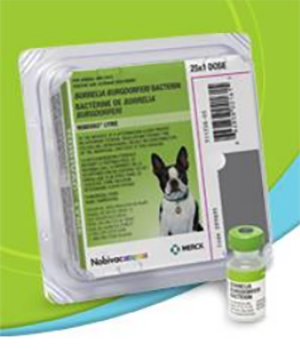One-of-a-kind protection
The only vaccine licensed to protect against inflammation and pathology of subclinical arthritis and its potential long-term repercussions1,5
Product Description
- Lyme vaccine designed to target the 2 key outer surface proteins (Osps) involved in disease transmission for a full level of protection
- Proven to induce borreliacidal antibodies that bind to OspA and OspC, forming a complex that attacks the cell membrane and kills Borrelia burgdorferi 1,5
- Proven to help prevent clinical disease such as arthritis – as well as at the subclinical level 5
- Highly effective: no serologic evidence of exposure to Borrelia burgdorferi 5
NOBIVAC® LYME PROVIDES PROVEN PROTECTION FOR CANINES
Our commitment to leadership is vaccine development that provides comprehensive protection against Lyme disease.
Indications:
Shown to be effective for vaccination of healthy dogs 8 weeks of age or older against Borrelia burgdorferi. Duration of Immunity is at least 1 year. Also been shown to be effective against subclinical arthritis caused by Borrelia burgdorferi. Recommended for use in healthy dogs 8 weeks of age or older.
NOBIVAC® LYME IS A SAFE CHOICE
- Proven safe and well tolerated in a field safety trial of more than 600 dogs
- 99.3% reaction-free
- Since 2009, Nobivac® Lyme has been safely administered to over 4 million dogs
ADMINISTRATION AND DOSAGE
- Subcutaneous injection
- Two 1 mL doses given 2 to 4 weeks apart
- Duration of immunity is at least 1 year
- Available in a 25 x 1 mL dose presentation
DISEASE INFORMATION
- Canine Lyme Disease
Efficacy
ANTIBODY ACTIVITY
THE BORRELIACIDAL DIFFERENCE
Only Nobivac® Lyme induces borreliacidal activity against both OspA and OspC1,5,80 Not all antibody responses are the same.
- “Multi-Osp protection” that induces antibodies against Osps other than OspA and OspC has not been shown to be relevant5,29,30
- Other Lyme vaccines may induce antibodies against OspC, but they are not borreliacidal—meaning they don’t kill Borrelia burgdorferi
- As a result, vaccines that only induce borreliacidal antibodies against OspA provide incomplete protection once OspC becomes the dominant protein expressed in the tick
- Only Nobivac® Lyme induces OspC borreliacidal antibodies that kill spirochetes in the tick midgut, those migrating from the midgut to the tick’s salivary glands, and those introduced into the dog80
COMPETITIVE COMPARISON
ONLY NOBIVAC® LYME OFFERS POWERFUL COMPARATIVE BENEFITS AND PROVEN SAFETY.
PREVENTS JOINT ABNORMALITIES
NOBIVAC® LYME IS SHOWN TO BE EFFECTIVE AGAINST SUBCLINICAL ARTHRITIS, IN ADDITION TO CLINICAL DISEASE5
Following vaccination with Nobivac® Lyme:
- No Borrelia burgdorferi were found in the joint
- No joint inflammation, stiffness, or lameness were observed5
- 40% of control dogs developed chronic joint inflammation5
- 27% of control dogs developed joint stiffness or lameness5
- Dogs exhibited no signs of Lyme disease–associated joint abnormalities5
TICK CHALLENGE STUDY
NOBIVAC® LYME IS HIGHLY EFFECTIVE IN KILLING BORRELIA BURGDORFERI AND PREVENTING INFECTION5
Tick challenge study confirms effectiveness.5
Following vaccination with Nobivac®, no B. burgdorferi were found.
The tick challenge study was a placebo-controlled trial involving thirty 8-week-old puppies. Dogs were challenged 3 weeks following second vaccination.
Professional Resources and Educational Materials
Keep your clinic and staff informed and aware of diseases and outbreaks.
Brochure
Lyme Disease Pet Parent Guide
Printable brochure to educate pet parents about their dog’s risk for Canine Lyme Disease. What is Lyme disease? What are the signs of Lyme disease? How serious is Lyme disease?
References:







 Go To United States
Go To United States Algeria
Algeria Argentina
Argentina Australia
Australia Austria
Austria Bahrain
Bahrain Belgium (Dutch)
Belgium (Dutch) Brazil
Brazil Canada (English)
Canada (English) Chile
Chile Colombia
Colombia Croatia
Croatia Czech Republic
Czech Republic Denmark
Denmark Ecuador
Ecuador Egypt
Egypt Finland
Finland France
France Germany
Germany Greece
Greece Hungary
Hungary India
India Indonesia
Indonesia Iraq
Iraq Ireland
Ireland Israel
Israel Italy
Italy Japan
Japan Jordan
Jordan Kuwait
Kuwait Lebanon
Lebanon Malaysia
Malaysia Mexico
Mexico Morocco
Morocco Netherlands
Netherlands New Zealand
New Zealand Norway
Norway Oman
Oman Panama
Panama Peru
Peru Philippines
Philippines Poland
Poland Portugal
Portugal Qatar
Qatar Romania
Romania Russian Federation
Russian Federation Saudi Arabia
Saudi Arabia South Africa
South Africa South Korea
South Korea Spain
Spain Sweden
Sweden Switzerland (French)
Switzerland (French) Taiwan
Taiwan Thailand
Thailand Tunisia
Tunisia Turkey
Turkey Ukraine
Ukraine United Arab Emirates
United Arab Emirates United Kingdom
United Kingdom Uruguay
Uruguay Yemen
Yemen Global
Global